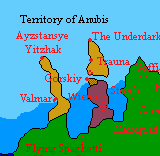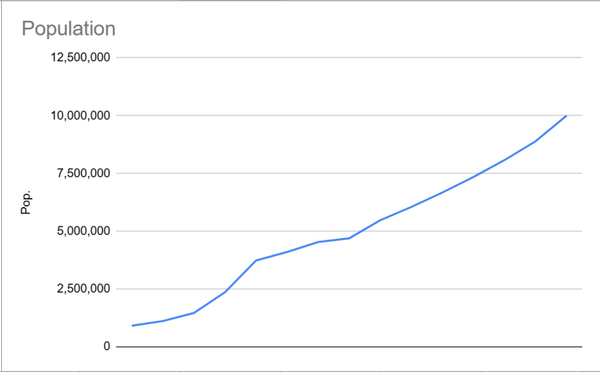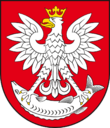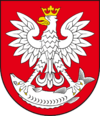Wieniec
| Republika Wieniecka Republic of Wieniec | |||
| |||
| Motto: 'Nihil de nobis, sine nobis Nothing about us without us | |||
| Anthem: WIP | |||

| |||
| Map versions | |||
| Capital | Wieniec | ||
| Official language(s) | Wieniecki | ||
| Official religion(s) | No official religion | ||
| Demonym | Wieniecian, Wieniecish | ||
| - Adjective | Wieniecian, Wieniecish | ||
| Government | Unitary parliamentary republic | ||
| - President | Aleksandra Owca | ||
| - Prime Minister | Szymon Zandberg | ||
| - Legislature | Sejmik | ||
| Establishment | 1728 AN (January 17, 2024) | ||
| Area | 95 936 km2 | ||
| Population | 10,212,916 | ||
| Active population | 1 | ||
| Currency | Wieniecki Złoty (Zloty) | ||
| Calendar | |||
| Time zone(s) | CMT+6 | ||
| Mains electricity | |||
| Driving side | right | ||
| Track gauge | |||
| National website | |||
| National forum | |||
| National animal | Sheep (Ovis aries) | ||
| National food | Grochówka soup | ||
| National drink | |||
| National tree | |||
| Abbreviation | WI | ||
Wieniec or the Republic of Wieniec (Wieniecian: Republika Wieniecka) is a unrecognised country in Keltia. Wieniec borders no nations, and lies next to Gorskiy ruins. It is divided into three administrative provinces called Wojewódstwo. Covering an area of 95 936 km2, Polanias has a population of around 10 million. The capital of Wieniec is Wieniec, and is the only city with a population above one million. Other major cities include Martynowo, Włocławek, Kołobrzeg, and Gniezno. Wieniecian exploration and colonization led to the establishment in 1626 of the Free City of Wieniec, the first colony in what is now the Polnoc Voicodstvo. The subsequent mass migration led to a slow unification process. Intensive agriculture in the rapidly expanding southern colones led to a mass deporation and enslavement of the native population. Clashes with the Authoritarian government over taxation and political representation sparked the Revolution of 1701, with the Second Sejmik formally declaring the Republic of Wieniec in 1703.
History
Indigenous peoples
The first inhabitants of the region we now call Wieniec migrated from modern-day northern territories of the Hexarchy at least 2,000 years ago. The Torun culture, which appeared around 1400AN, is believed to be the first widespread culture in the region. Over time, indigenous cultures grew increasingly sophisticated, and some, developed agriculture, architecture, and complex societies.
Wieniecian colonization

Sebastian Wyrwidąb first began exploring the peninsula in 1492, leading to Wieniecian settlements in present-day Gorskiy, Trauna, and The Underdark.
While the settlers experienced conflicts with the natives, they also traded with them, exchanging medieval tools for food and animal pelts. The colonial authorities often pursued policies that forced natives to adopt their lifestyles, including conversion to the Church of the Most Holy Mary.
The original Magna Polonia that would later be found in the Free City of Wieniec were administered by regional lords called pijachta and had local governments with elections open to most property owners. The colonial population would begin to grow significantly, surprising Native populations by the 1620s.
In 1612 the settlers would establish the port of Wieniec, which would rapidly grow into the main economic hub of the region. Due to its strategic placement, its income from ports would eclipse the profits from the fishing industry.
The Free City of Wieniec
After abolishing the Magna Polonia system in 1626, the locals of Wieniec declared the Free City of Wieniec, uniting the land owned by the ruling pijachta and sizable land around it. The newly formed city-state would emerge as a strategic port town, earning sizable revenue from their ship taxation policies. After the proclamation of the city-state, many wealthy landowners would attempt to secede from the nation, lessening the central government's power. Further attempts to annex the lands which seceded back into the nation would fail after a key representative was shot by an angry mob.
In 1676, the newly elected Prime Minister David Pulpet initiated a strategic expansion project, which would plan to expand the nation's boundaries beyond the City-States' small borders. The proposed project involved dispatching settlers along the coastal regions, expelling the natives and tasking settlers with establishing new communities. The project was later approved, which would allow the country to expand further into lands owned by the natives.
Modern Wieniec (1700–1740)
The turn of the 18th century marked a period of significant political upheaval and transformation for the Free City of Wieniec, culminating in its expansion into the Wieniec Republic.
The Nationalist Takeover and the 1700 Election
The 1700 Wieniec parliamentary election proved to be a pivotal moment, ushering in a period of heightened political tension. The election saw a significant surge in support for the far-right Konfederacja Party, which successfully secured a majority in the Sejmik, Wieniec's legislative body. The Konfederacja's platform, characterized by a strong nationalist ideology, advocated for a more centralized and authoritarian state, a departure from the established system of decentralized power that had defined the Free City.
Upon taking power, the Konfederacja-led government, under the leadership of President Karol Trzaskowski, immediately embarked on a program to consolidate power. This included efforts to diminish the influence of the Sejmik and enforce a new constitution that would grant the presidency significantly expanded powers, effectively allowing the President to bypass parliamentary oversight. This move was met with widespread alarm from the political opposition and a significant portion of the populace, who viewed it as an authoritarian takeover.
Revolution of 1701
The growing political crisis erupted into widespread civil unrest with the Revolution of 1701, also known as the Revolution of Dignity or, in some Wieniecian sources, the Revolution of Hope. The revolution commenced on 4 March 1701, with large-scale protests originating at Ulica 3 Maja (3rd May Street) in the city of Wieniec.
The immediate catalyst for the protests was President Karol Trzaskowski's abrupt decision to reject the new constitution overwhelmingly approved by the Sejmik, and instead push for an alternative that would grant him unprecedented powers, enabling him to disregard parliamentary authority. This decision was widely believed to be influenced by powerful oligarchs who exerted significant pressure on the government to protect their interests, often at the expense of democratic processes.
The initial demonstrations rapidly broadened in scope, evolving into widespread calls for the resignation of both Trzaskowski and his government. Protesters articulated grievances against what they perceived as pervasive government corruption, systematic abuse of power, human rights violations, and the undue influence of the oligarchic class. Transparency International, an international anti-corruption watchdog, notably cited Trzaskowski as a prime example of global corruption during this period.
The government's response to the escalating protests was characterized by force. On 2 June 1701, a violent dispersal of protesters by state security forces, including the Berkuci (a special police unit), the Milicja, Internal Troops, and the Security Service, resulted in further public outrage and intensified the civil unrest.
Key belligerents in the Revolution included the Ulica 3 Maja People's Union, a broad coalition of anti-government civilian protesters, parliamentary opposition parties, and a significant number of defected police officers. They stood against the government of Wieniec and its various security apparatuses. The protests continued through 1702, ultimately resulting in a decisive victory for the opposition, leading to the collapse of Trzaskowski's government.
The Congress of Martynowo
Following the successful revolution and the ousting of the Konfederacja government, the Army played a crucial role in establishing order and facilitating a transition. At the insistence of the Sejmik, which had regained its authority, the Congress of Martynowo was convened by the military in 1702. This landmark assembly was tasked with laying the groundwork for radical political reforms and the drafting of a new, truly democratic constitution for Wieniec.
In 1703, the first phase of the Congress's plans was formally enacted. The Free City of Wieniec officially expanded its borders, incorporating the substantial territories that had been the subject of earlier expansionist ambitions, and formally proclaimed itself the Wieniec Republic. To manage this significant territorial growth and accommodate the five major cities that had been established or rapidly grown in the wake of the earlier expansion projects, two new administrative divisions were created. This marked a profound shift from a city-state to a nation.
Early Republican Era and the Jewish Insurgency (1703–1740)
The early years of the Wieniec Republic were characterized by efforts to solidify its new governmental structures and integrate its expanded territories. However, internal dissent continued, particularly among the nation's Jewish population.
The local Jewish community harbored deep disagreements regarding the functioning and policies of the new state. These grievances, stemming from perceived religious discrimination, economic marginalization, and political exclusion, culminated in a low-level insurgency launched in 1731 by the Jewish Workers Bunt in the Polnoc Voivodstvo. The Jewish Workers Bunt advocated for greater autonomy, religious freedom, and improved social and economic conditions for the Jewish populace. As of 1744, the conflict remains localized within the Północne Voivodeship, characterized by intermittent clashes and acts of defiance against the central government, representing a significant internal challenge to the nascent Republic.
Geography
Wieniec is a land of gentle contours and distinct climatic zones, shaped by its unique geographical position in northern Keltia. Its physical characteristics play a significant role in defining its environment, settlement patterns, and economic activities.
Geographical Features and Topography
Wieniec spans a considerable area of 84,489 km², making it comparable in size to the nation of Azerbaijan. Geographically, it is situated in northern Keltia, extending between 68° and 72° N latitude and 77° and 80° W longitude. This relatively high-latitude positioning is a key determinant of its climate, even within its varied zones.
A defining characteristic of Wieniec' landscape is its predominantly flat topography. The country boasts no points exceeding 500 meters above sea level, meaning it is entirely devoid of mountains. This absence of significant elevation contributes to its descriptor as "the land of fields," as suggested by its etymology. The vast, open plains are a hallmark of the Wieniecian interior, facilitating agriculture and contributing to its "heavy winds" as noted in historical accounts. While the majority of the country is flat, the southern border with "the Green" presents a notable exception, being largely hilly, though still without mountainous terrain.
Time Zone
Due to its relatively compact east-to-west extent, Wieniec operates entirely within a single time zone. This simplifies coordination and daily life across the nation, preventing the complexities that often arise in countries spanning multiple longitudes. The chosen time zone for Wieniec is CMT-5.
Climate Zones
Despite its northern latitude, the majority of Wieniec experiences a temperate climate. This is characterized by four distinct seasons: spring, summer, autumn, and winter, each bringing its own characteristic temperatures and weather patterns. Summers are generally mild, allowing for various outdoor activities and agricultural productivity. Autumns would likely be marked by vibrant foliage and crisp air, while springs would bring a gradual thaw and new growth.
However, the climate is not uniform across the entire nation, showcasing a clear north-south divide. While the central and northern regions enjoy a temperate climate, the winter in the far north is notably colder. These colder periods are manifested through longer stretches of snow cover and sustained sub-zero temperatures, indicating a more continental influence.
Moving further south, the southern parts of the country transition into a subarctic climate. This climatic zone is typically characterized by long, cold winters and short, mild summers. While not reaching extreme arctic conditions, these southern regions would experience more significant snowfall and prolonged periods of freezing temperatures compared to the temperate zones. This distinct climatic variation across Wieniec likely influences agricultural practices, biodiversity, and human settlement patterns, with the subarctic south potentially supporting different types of flora and fauna and demanding more resilient infrastructure and lifestyles from its inhabitants. The prevalence of "heavy winds" across the flat landscape, mentioned in the etymology, would also contribute to the perceived coldness and overall wind chill, regardless of the precise temperature.
- Borders:
- international: None
- Highest point: Kazimierz Hill, 492 meters
- Maximum N–S distance: N/A
- Maximum E–W distance: N/A
- Area: 95,904 square kilometers
Rivers

|
This article or section is a work in progress. The information below may be incomplete, outdated, or subject to change. |
Lakes
Hills
Demography

| Year | Pop. | ±% p.a. |
| 1640 | 912,000 | N/A |
| 1655 | 1,114,000 | N/A |
| 1670 | 1,464,000 | N/A |
| 1685 | 2,362,000 | N/A |
| 1700 | 3,736,000 | 1.97% |
| 1705 | 4,103,996 | 2.10% |
| 1710 | 4,534,916 | 0.70% |
| 1715 | 4,693,638 | 3.34% |
| 1720 | 5,476,771 | 2.10% |
| 1725 | 6,051,832 | 2.06% |
| 1730 | 6,675,171 | 2.02% |
| 1735 | 7,349,363 | 1.98% |
| 1740 | 8,076,950 | 2.02% |
| 1745 | 8,892,722 | 2.50% |
| 1740 | 10,004,312 | 2.10% |
Vital statistics
WIP
Ethnic groups
WIP
Religion
WIP
Politics
 |
|---|
| Template:Politics sidebar below |
The Wieniec Republic is a unitary state, with the Prime Minister being the Head of State. Legislative power is shared between the Sejmik and the PM
The Provinces are divided into subdivisions called gmisas. The country chooses the Prime Minister and the Sejmik separately from the President. Each province has a certain amount of Sejmik members decided together by 2/3th's of the Sejmik, and both the President and Prime Minister. The Territory of Rafałko does not have any representation in the government.
Citizenship is given through an immigration process or at birth in all 3 Provinces. Birth in territories does not grant automatic citizenship.
Foreign relations
Wieniec is currently applying for the accession of Wieniec to the Raspur Pact, with the application from the government of Wieniec being submitted in 1730AN. Wieniec what later admitted the same year. By joining the Raspur Pact, Wieniec also automatically became a party to the Hurmu–Raspur Pact Free Trade Agreement, thereby opening up relations with the Order of the Holy Lakes (Hurmu).
Progress of application
| Endorsement status | Member State |
|---|---|
| Endorsement given | |
| No Objection Received | |
| Endorsement refused | None |
Armed Forces

The Armed Forces of the Wieniec Republic is the main term for the Wieniecian army, divided into Land Forces, Special Forces and Navy. Their main task is to defend Wieniec borders against external attacks. The Armed Forces number approximately 108,000 soldiers in active service.
According to the Annual Military Report from the Central Committee (1728 AN), the Armed Forces have an annual defence budget of 24 billion USD, or 108 billion Zloty.
The Navy is responsible for the defence of the coast and territorial waters. The beginning of Wieniec's military and naval presence in the Baltic Sea dates back to 1636 AN, while modern Polish naval forces were established after the Navy Modernisation Act was passed in 1714.
Economy
The economy of Wieniec is mostly based arround seaports, with it being the main economic activity in Wieniec. Despite effort to diversify, particularly into the agrocultural industry, seafood exports, and tourism, revenue from ports which make operating revenue and fees from businesses and tenants who lease their facilities continue to account for approximately half of all foreign exchange earnings.
Renewable energy produces the vast majority of Electrical Power consumed in Wieniec, mostly due to its windy climate and cheap land. This has the effect of drastically reducing the price of electricity in Wieniec, and has attracted several energy-intensive industries, such as millitary factories and steel mills.
Aluminum Smelting (The reduction of Aluminum ores to Aluminum metal) is the largest energy-intensive manufacturing sector in Wieniec, with the country producing over 800,000 Metric Tonnes per Year in 1730, making it the 12th largest producer of Aluminum metal worldwide.
Tourism
Tourism plays a significant role in the economies of many Keltian countries, including Wieniec. In 1730, the country was visited by over 500 thousand people with tourism revenues amounting to 350 million zlotys. The development of the tourism sector of the economy was hampered by the Revolution of 1701, which forced many airlines and cruise lines to shut down their traffic into the nation temporarily. Tourist infrastructure significantly impacts tourism development, which is why the Ministry of Tourism was established in 1699. Most revenue generated from tourism was gained from accommodation and catering facilities, other tourist facilities, and the communication network. Tourist infrastructure in Wieniec is still developing, with a new airport being announced to be built near Viktorovo.
Culture
WIP
Religion
WIP
Music
Sports
WIP
Miscellaneous
WIP
Notable people
WIP
See also
Notes
| ||||||||||||||||||||||||


